71.
6.1 Sequential Switching Networks
In Chapter 1 we defined sequential circuits as those in which some outputs feed back as inputs. Feedback is a necessary condition for sequential circuits, forcing the outputs to depend on the entire history of input sequences.A digital alarm clock is a sequential circuit. The output of the clock is the current time of day, updated every second. The current setting of the clock determines the next output. The circuitry uses an independent, periodic reference signal to determine exactly when to change to a new output. This signal could be provided by an internal crystal that oscillates at a known frequency, or it could be
(and frequently is) the 60-cycles-per-second alternating current that is delivered to your house by the power company. A sequential circuit counts the number of transitions in the reference signal to determine when to perform some action, such as advancing the clock. Interestingly, this independent signal oscillating at a known frequency is often called a clock. Now let's recall the traffic light controller of Chapter 1. This circuit must "remember" the current light configuration before it can determine which configuration to advance to next. The unique configurations of the circuit are called its states. The traf\xde c light controller has exactly four states
(north-south green/east-west red, north-south yellow/east-west red, north-south red/east-west green, north-south red/east-west yellow), stored in special circuit structures called memory elements. Although the traffic light controller is a sequential circuit in its own right, these memory elements are the simplest, most primitive sequential circuits. 6.1.1 Simple Circuits with Feedback
We can implement a simple memory element from cascaded inverters. This is the basic circuit structure used in all static RAM(random-access memory) designs. Alternatively, we can build a simple memory structure from cross-coupled NOR and NAND gates. These two types of memory elements form the basic building blocks of the latch and flip-flop memory elements we will introduce in this chapter. We begin our examination of sequential logic with these very primitive structures. 
Inverter Chains Consider the almost trivial circuit of Figure 6.1. It contains nothing more than two inverters in series, with the output of the second-stage inverter fed back as input to the first-stage inverter. A logic 1 at the input of the first inverter becomes a 0 at its output. The 0 is mapped to a logic 1 at the output of the second stage, which reinforces the value at the first inverter's input. A similar argument holds for a 0 at the input. Once a value is inserted at the input, it can be held indefi-nitely by the circuit.
Of course, the problem with this circuit is how to get a value into the memory element in the first place. Some value will be there when power starts up, but for this circuit to be an effective building block, we must be able to select the value to be stored. We need extra logic to set the memory element to a specific value. The feedback path must be broken while a new value is connected to the input.

One way to build such a memory element is shown in Figure 6.2, where CMOS transmission gates are used to implement a 2:1 multiplexer on the inputs to the memory element. When we assert LD (load), the feedback path is broken, and the value at input A can be stored in the element. When LD is unasserted, the input from A is broken, and the feedback path is reestablished. Note that because of the critical nature of the timing of the signals in these kinds of circuits, many logic simulators have difficulty in modeling such signal flows, even though the physical circuit would operate without difficulty.
Cascaded inverters can serve a purpose besides storage. They can be used to build circuits whose outputs oscillate between low and high voltages. Such circuits are called ring oscillators.
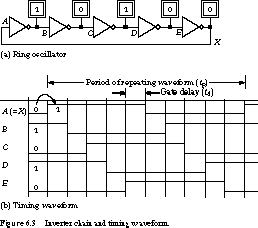
Figure 6.3(a) shows an inverter chain, and Figure 6.3(b) gives the associated timing waveform. The timing waveform begins with node A (also labeled X) about to switch from 0 to 1.
The odd number of inverters leads to oscillatory behavior that repeats every tp time units. This is called the period of the signal. Duty cycle is defined as the percentage of time a signal is high during its period. In the figure, the signal has a 50% duty cycle.
In the ring oscillator, the duration of the period depends on the number of inverters in the chain. In this case, we have five inverters with unit delay (that is, a gate delay of 1 time unit). The high time of the waveform is five time units: five times the gate delay of a single stage. If we had a seven-inverter chain, the period would be 14 time units: seven units high, seven units low.
To see why this is the case, let's examine Figure 6.4.
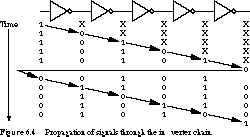
Each row gives the logic state associated with the nodes of the circuit. The rows differ in time by a single gate delay. Starting with a 1 at the input to the first stage, the signal propagates through the inverters, alternating its logic value between the stages. Once the signal emerges from the last stage, it is fed back to the first stage as the complemented value. The propagation repeats. In examining any node in the circuit, we discover that it stays high or low for exactly five gate delays.
Cross-Coupled NOR Gates as a Basic Memory Element An alternative method for building circuits with state is to use cross-coupled NOR gates (NAND gates can be used in a similar fashion).

Figure 6.5 shows two alternative ways to represent cross-coupled NORs. Recall that a NOR gate with a 0 input acts like an inverter with respect to the other input: if the nonzero input is 1, the NOR's output is 0, and if it is 0, the NOR's output is 1. Similarly, if one of the NOR's inputs is 1, the output is always 0. One of the NOR gates of Figure 6.5 acts like an inverter while the other injects a 0, depending on the settings of the R and S inputs.
Suppose R = 1 and S = 0. Since the R input is 1, the Q output is reset to 0 independent of the ![]() input to the first NOR gate. With S at 0, the Q input is inverted to form the
input to the first NOR gate. With S at 0, the Q input is inverted to form the ![]() output. R is called the reset input.
output. R is called the reset input.
Now suppose that R = 0 and S = 1. The same arguments apply as in the previous case. ![]() is reset to 0. When this output is fed back to the first NOR gate, it is inverted, and Q is set high. Hence S is called the set input. When R and S are both 0, the NOR gates behave like chained inverters and will hold their current output values indefinitely. This configuration of NOR gates is called an R-S latch.
is reset to 0. When this output is fed back to the first NOR gate, it is inverted, and Q is set high. Hence S is called the set input. When R and S are both 0, the NOR gates behave like chained inverters and will hold their current output values indefinitely. This configuration of NOR gates is called an R-S latch.
Timing Behavior of the Cross-Coupled NOR Gates The timing behavior of these gates is shown in the timing waveform of Figure 6.6.
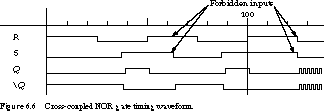
Q is set high when S is asserted and is reset low when R is asserted. Whenever R and S are both zero, the outputs remain unchanged.
What happens when both R and S are asserted? Q cannot be both 1 and 0 simultaneously! This input condition is forbidden in normal operating conditions. Both Q and ![]() are driven to 0, violating the assumption that the two outputs are always complements of each other.
are driven to 0, violating the assumption that the two outputs are always complements of each other.
When one of R or S is returned to the unasserted state, the remaining asserted signal determines the steady-state output values of Q and ![]() . In the first case of forbidden inputs in Figure 6.6, R remains asserted while S is left unasserted. Q stays at 0, while
. In the first case of forbidden inputs in Figure 6.6, R remains asserted while S is left unasserted. Q stays at 0, while ![]() goes to 1. Comparable behavior will be observed if R becomes unasserted while S stays asserted.
goes to 1. Comparable behavior will be observed if R becomes unasserted while S stays asserted.
Now suppose that R and S return to 0 simultaneously. This is the second case of forbidden inputs in Figure 6.6. The outputs actually oscillate. Q and ![]() are initially 0. When R and S go to 0, the NOR gate outputs go to 1. But when these are fed back to the inputs, the NOR gates behave like inverters, switching the outputs back to 0. This oscillatory behavior is called a race condition.
are initially 0. When R and S go to 0, the NOR gate outputs go to 1. But when these are fed back to the inputs, the NOR gates behave like inverters, switching the outputs back to 0. This oscillatory behavior is called a race condition.
Theoretically, the race condition can continue as long as R and S are 0. However, the delay through the two NOR gates is not perfectly matched, and one of Q and ![]() will be driven to a new value before the other, stopping the oscillations. To avoid the race condition, we restrict the R and S inputs never to be 1 at the same time.
will be driven to a new value before the other, stopping the oscillations. To avoid the race condition, we restrict the R and S inputs never to be 1 at the same time.
We summarize the behavior of the cross-coupled NOR gates in the functional truth table of Figure 6.7.

When R = S = 0, the circuit holds its current output-in other words, the output is the same as it was for the last setting of the inputs. When one of R or S is set to 1, the output is forced to 0 or 1, respectively. When both inputs are 1, the outputs oscillate between 0 and 1.
Another representation of the behavior of cross-coupled gates is called the state diagram. The diagram consists of nodes and arcs. The nodes represent unique configurations or states of the circuit. The arcs are labeled with the input combinations that cause a transition from one state to another.
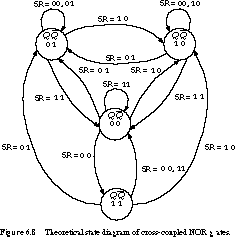
Figure 6.8 shows the state diagram for the cross-coupled NOR gates. The circuit's state depends on the values of the outputs Q and ![]() , so there are four possible states, one for each combination of possible values for the two outputs. Since there are two inputs, S and R, there are exactly four transitions from each state, one for each of the possible input combinations.
, so there are four possible states, one for each combination of possible values for the two outputs. Since there are two inputs, S and R, there are exactly four transitions from each state, one for each of the possible input combinations.
The states labeled 01 and 10 are the normal configurations of the circuit. When set (S) is asserted, we enter state 10 (Q = 1, ![]()
= 0). When reset (R) is asserted, we change to state 01 (Q = 0, ![]()
= 1). When S and R are both 0, we hold in the current state.
When we encounter the forbidden input configuration S = R = 1, the circuit enters state 00. It stays in this state as long as these inputs are asserted. As soon as one input returns to 0, the circuit returns to state 01 or 10.
If the current state is 00 and S = R = 0, the circuit enters state 11. It does not stay there very long, immediately returning to state 00 if S and R remain 0. If the delays through the gates are perfectly matched, the circuit can oscillate between these two states forever. Of course, this does not make a very useful memory element.

Figure 6.9 gives a state diagram we constructed by observing the behavior of a real cross-coupled NOR gate circuit. The actual circuit does not oscillate between 00 and 11 indefinitely, but rather ends up sometimes in state 10 and sometimes in state 01. This is the true meaning of a race condition in sequential logic: the resulting state depends on the circuit's time-dependent behavior and cannot be predicted in advance. The race condition is most easily avoided by never putting the circuit into state 00 in the first place.
6.1.2 State, Clock, Setup Time, and Hold Time
We are now ready to introduce some definitions about the timing waveforms of sequential networks. The output of a sequential circuit is a function of the current inputs and any signals that are fed back to the inputs. We call these feedback signals the current state of the circuit. A periodic external event, called a clock, determines when the circuit will decide to change the current state to a new state. When the clocking event occurs, the circuit samples its current inputs and state and computes its new state.As an example, consider the digital alarm clock we already discussed. Part of its state is the current time of day. Other parts of the state include such aspects of the clock's configuration as whether or not the alarm is set and the time the alarm should go off. Suppose that the oscillating reference signal, the true clock, becomes asserted once every second. When the clock is asserted, the digital clock advances the display by 1 second and checks whether it matches the alarm time. If it does and the alarm is set, then the sequential circuit sounds the alarm. The digital clock's new state now indicates that the alarm is on.
We can designate the clocking event as either the low-to-high or high-to-low transitions of the clock. It is important that the inputs determining the new state remain unchanged around the clocking event. We define a special window of time by two constraints: the setup time before the clock event and the hold time after the event. If the inputs do not change within this window, the state will be updated in a correct and unambiguous way. If they do change, the effect on the state is undefined.
Let's be more precise. The setup time, Tsu, is the minimum time interval preceding the event during which the input must be stable to be validly recognized. The hold time, Th, is the minimum time interval after the edge of the event during which the input signal must be stable to be validly recognized.

These concepts are shown in Figure 6.10 for a rising clock edge event. The input must remain stable at least a setup time before the reference clock edge and at least a hold time after the edge for the input signal to be recognized as a logic 1. If these constraints are not satisfied, the input may be interpreted as a 1 or a 0 or some unrecognizable value between 0 and 1. It is extremely dangerous to allow input signals to change very close to the sampling event, as we shall see in Section 6.4.
Latches and Flip-Flops Let's return to the concept of the sampling event. Think of this event as an enable signal that instructs the memory element to examine its input to change its state. We can use a single clock to synchronize the update of many memory elements in our system.
Figure 6.5 already showed the basic R-S latch. Primitive memory elements actually fall into two broad classes: latches and flip-flops. When the memory element's outputs immediately change in response to input changes, they are called transparent outputs. The R-S latch has transparent outputs.
If a latch has only data inputs, like R and S, it is called an unclocked latch. Level-sensitive latches have an additional enable input, sometimes called the clock.
Level-sensitive latches continuously sample their inputs while they are enabled. Any change in the level of the input is propagated through to the output.

The circuit shown in Figure 6.11 is a level-sensitive latch. The holding state occurs when both inputs are 1, the forbidden state when both inputs are logic 0, the latch is set when ![]()
= 0, ![]()
= 1, and the latch is reset when ![]()
= 1, ![]()
= 0. The enable signal is also active low. When it is high, the output from the first stage of NOR gates is forced to 0, thus placing the cross-coupled second stage in the holding state.
When the enable signal is unasserted, the last value of the inputs determines the state held by the latch. The "latched" value is determined by the window formed from the setup and hold times around the falling (high-to-low) edge of the enable signal.
Flip-flops differ from latches in that their outputs change only with respect to the clock, whereas latches change output when their inputs change. We can characterize flip-flops on the basis of the clock transition that causes the output change: there are positive edge-triggered, negative edge-triggered, and master/slave flip-flops.
A positive edge-triggered flip-flop samples its inputs on the low-to-high clock transition. To be properly recognized, the input must be stable within the setup and hold time window around the clock edge. The outputs change a propagation delay after the rising clock transition.
A negative edge-triggered device works in a similar fashion, with the input sampled on the high-to-low clock transition. The outputs change a propagation delay after the falling edge of the clock. Under this classification, a master/slave flip-flop is indistinguishable from the negative edge-triggered device, except that it exhibits a strange behavior called "ones catching," which we will discuss later.  Table 6.1 summarizes the different attributes of latches and flip-flops.
Table 6.1 summarizes the different attributes of latches and flip-flops.
Timing Examples To better understand the terms just introduced, let's consider two memory elements: a positive edge-triggered flip-flop (such as a TTL 74LS74) and a level-sensitive latch (such as a 74LS76). Each has a single data input D, a clock input C, and an output Q. The block diagrams are shown in Figure 6.12.
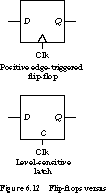
We normally represent edge-triggered devices with the clock input as a triangle. A negative edge-triggered device has an additional negative logic bubble at the clock input.
We compare the timing behavior of the two types of devices in Figure 6.13.

The outputs differ only when the input changes while the clock is asserted. This is because the latch immediately responds to changes in the input while the clock is high but the flip-flop does not.
The definitions of the setup and hold times are quite different for these two devices.
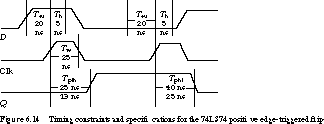
Figure 6.14 gives the timing waveforms for the 74LS74 positive edge-triggered flip-flop. Tsu is 20 ns and Th is 5 ns. In addition, the clock signal has a minimum duration, Tw = 25 ns. The figure also defines Tphl, the propagation delay between the rising edge of the clock and the change in the output from high to low, and Tplh, the propagation delay from the rising clock edge to a low to high change in the output. Tphl is 40 ns maximum, 25 ns typical, and Tplh is 25 ns maximum, 13 ns typical.

Figure 6.15 displays the timing specifications for the 74LS76 clocked transparent latch. As for the flip-flop, the quantities Tsu, Th, and Tw are defined to be 20 ns, 5 ns, and 20 ns, respectively. However, the setup and hold times are defined relative to the falling edge. The specifications for Tphl and Tplh are more complex, because they must be defined for two different events: from when the input changes to a corresponding change in the output (D » Q) and from when the clock becomes asserted to when the output changes (C » Q). Of course, the clock must be asserted before the input can influence the output. Tphl (D » Q) is 16 ns maximum, 7 ns typical; Tphl (C » Q) is 25 ns maximum, 14 ns typical; Tplh (D » Q) is 27 ns maximum, 15 ns typical; and Tplh (C » Q) is 27 ns maximum, 15 ns typical.
6.1.3 The R-S Latch
The R-S latch can hold its current state, reset the state to 0, or set the state to 1. The detailed truth table for the R-S latch is shown in Figure 6.16.
Note that the inputs are S, R, and Q at a given time t, and the output is Q at time t + ý, where ý represents a small increment in time. Q(t) is the current state of the latch, and Q(t + ý) is the next state.

A K-map for the truth table is given in Figure 6.17. We can derive the following so-called characteristic equation to describe the next state in terms of the inputs and current state:
This equation is a convenient shorthand for describing the memory element's behavior. For example, if S = 1 and R = 0, the next state Q+ becomes 1 independent of the current state. When S = 0 and R = 1, the next state is forced to be 0, independent of the current state.
Level-Sensitive R-S Latch The gated R-S latch is an extension of the basic R-S latch that we saw in Figure 6.11. This device adds the ability to latch a new state under the control of an external enable signal. When the enable signal is asserted, the circuit's R and S inputs affect the state. When enable is not asserted, the latch holds its current state.
The timing behavior of the level-sensitive R-S latch is shown in Figure 6.18.
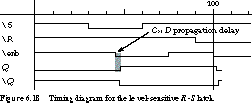
The propagation delay from when the clock is asserted to when the output changes (C » D) is shown in the diagram.
6.1.4 The J-K Flip-Flop
It would be useful if we could eliminate the forbidden inputs to the R-S latch. Consider the circuit diagram of Figure 6.19.
By feeding the Q and ![]() outputs back to the inputs and gating these with external set and reset control inputs
outputs back to the inputs and gating these with external set and reset control inputs (now called J and K, respectively), we guarantee that the internal R and S are never simultaneously 1 (this assumes that Q and ![]() are never both 1
are never both 1).
In addition to avoiding the forbidden state, we introduce a new capability: complementing the current state, or toggling. For example, if Q is 1, ![]() is 0, and J and K are both 1, then the inputs presented to the internal latch are R
is 0, and J and K are both 1, then the inputs presented to the internal latch are R = 1, S = 0. This flips Q to 0 and ![]() to 1. If Q starts out as 0, then
to 1. If Q starts out as 0, then ![]() is asserted, as is the internal S signal. Once again, this will cause Q to toggle its value to 1.
is asserted, as is the internal S signal. Once again, this will cause Q to toggle its value to 1.
This is shown in the truth table of Figure 6.20.
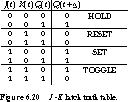
All input combinations lead to useful functions for the J-K latch: hold, reset, set, and toggle. The characteristic equation is![]()
Notice how nicely the characteristic equation summarizes the behavior of the J-K flip-flop. When J = 1, K = 0, Q+ = Q + ![]() , which is always 1
, which is always 1 (set). Q+ is always 0 when J = 0, K = 1 (reset). Finally, when J = 1, K = 1, Q+ = ![]()
(toggle).
Problems with the Basic J-K Flip-Flop If we actually built this circuit, we would \xde nd an interesting problem as soon as the circuit is placed into the toggle mode. The output toggles forever (or at least until one of J or K returns to 0), as we show in Figure 6.21.

The problem is that the toggle signal remains asserted while the outputs change, thus flipping the values of R and S presented to the internal latch, causing it to toggle again. The process continues until the toggle condition is removed.
Solution: Master/Slave Flip-Flop This leads us to an alternative way to build a J-K memory element, called a master/slave flip-flops. The basic idea is to build the memory element in two stages. The first stage, the master, accepts new R-S inputs and generates the outputs P and ![]() on the rising edge of a clock signal. The second stage, the slave, accepts P and
on the rising edge of a clock signal. The second stage, the slave, accepts P and ![]() as inputs on the falling edge of the clock and changes its outputs after the falling edge. By the time the outputs propagate back to the \xde rst stage, the clock signal has been removed, guaranteeing that the outputs cannot toggle again
as inputs on the falling edge of the clock and changes its outputs after the falling edge. By the time the outputs propagate back to the \xde rst stage, the clock signal has been removed, guaranteeing that the outputs cannot toggle again (at least not until the next rising clock edge).
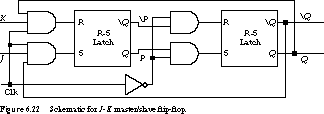
The schematic for this flip-flop is shown in Figure 6.22 and its associated timing diagram is given in Figure 6.23.

The timing diagram illustrates some important points about J-K master/slave flip-flops. First, the P, ![]() outputs of the first stage track the Q,
outputs of the first stage track the Q, ![]() outputs of the second stage. The latter outputs change a propagation delay after the falling edge of the clock signal. Second, a general property of master/slave flip-flops is called ones catching. If an input is high any time during the clock period, it will be interpreted as a one for computing the output.
outputs of the second stage. The latter outputs change a propagation delay after the falling edge of the clock signal. Second, a general property of master/slave flip-flops is called ones catching. If an input is high any time during the clock period, it will be interpreted as a one for computing the output.
To see this behavior, let's trace the inputs and their effect on the outputs. Initially the flip-flop has 0 as its output. J goes high, and after the clock also goes high, P comes high. When the clock goes low, P and ![]() are gated across to the second stage, causing its output Q to go high. On the next rising clock edge, J and K are both low, so the first stage holds its state. Midway through the clock period, however, K comes high, causing the first stage to reset. The 0 output is passed on to the second stage, whose output goes low after the falling edge of the clock.
are gated across to the second stage, causing its output Q to go high. On the next rising clock edge, J and K are both low, so the first stage holds its state. Midway through the clock period, however, K comes high, causing the first stage to reset. The 0 output is passed on to the second stage, whose output goes low after the falling edge of the clock.
The ones catching phenomenon is clearly shown in the next input con-dition, where J changes from low to high to low while the clock is asserted. Even though the input is back to zero by the time the clock goes low, the output is still set. You must be careful when using master/slave flip-flops with combinational logic that suffers from 0-hazards. Any glitch at the inputs to the flip-flops could cause unintended state changes.
If the latches are constructed from the NAND gates (that is, ![]() -
-![]() latches
latches), there is an analogous problem with zeros catching. If the clock is asserted and the J or K input temporarily changes through zero, the associated set or reset operation will take place.
The rest of the input configurations cause the outputs to toggle from 1 to 0 to 1 to 0. Note that the outputs make only one state change per clock period and that the output changes only after the falling edge of the clock.
6.1.5 Edge-Triggered Flip-Flops: D Flip-Flops, T Flip-Flops
J-K flip-flops solve the forbidden state problem by guaranteeing that the inputs to the internal latches are never asserted simultaneously. The resulting toggle function can lead to oscillating outputs. The master/slave flip-flop solves the oscillation problem by sampling inputs only when the clock is high, generating new outputs just after the clock goes low. But now we have the problem of ones or zeros catching.To solve this new problem, designers created edge-triggered flip-flops. Rather than sample inputs during the high time of the clock, edge-triggered devices sample inputs only on a rising
(positive edge-triggered) or falling (negative edge-triggered) clock edge. Let's look at the circuit schematic for a negative edge-triggered D flip-flop in Figure 6.24
(this can be changed to a positive edge-triggered device by using the clock's complement). 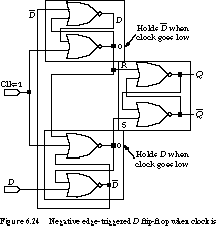
Unlike R-S and master/slave J-K devices, a D flip-flop has only one data input. It stores the value presented on this input when the clock signal performs the appropriate transition. Its characteristic equation is simply Q+ = D. Let's see how it works.
Operation of the D Flip-Flop The operation of an edge-triggered device is considerably more complex than that of the master/slave flip-flop. The circuit of Figure 6.24 contains three communicating latches. The bottom latch samples the D input while the top stage holds ![]() . The output from the bottom latch drives the set input of the final stage latch, while the top latch provides its the reset input.
. The output from the bottom latch drives the set input of the final stage latch, while the top latch provides its the reset input.
The figure shows the state of the circuit when the clock is high. The clock forces the outputs of the top and bottom latches to zero, thus keeping the final stage R-S latch in its holding state. Any change in the D input will be sampled by the top and bottom latches, but these changes are inhibited from affecting the final stage latch.
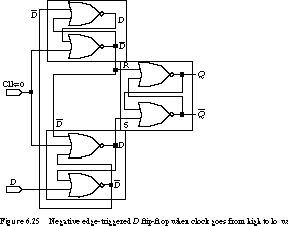
Figure 6.25 shows what happens when the clock initially changes from high to low. The output NOR gates in the top and bottom latches now act like inverters. The previously sampled value of D is presented to the S input, while ![]() drives the R input. If D
drives the R input. If D = 1, the R-S latch outputs a 1. Otherwise it outputs a 0.
What happens when the clock is low, but D changes?

Figure 6.26 shows the state when the input changes to D', which is different from the previously sampled value D. This new input forces the output of the NOR gate to change from 1 to 0, since one input must be a 1 and the other a 0. By driving this circuit node to 0, gates 2, 4, and 5 are guaranteed to hold their previous values. D' can affect the circuit only when the outputs of gates 2 and 4 are forced to 0. This will happen only when the clock next goes high.
An examination of this circuit should make you appreciate the need for setup and hold time specifications for flip-flops. If the D input changes too close to the appropriate clock edge, its value may not be held correctly by the top and bottom latches. Also, you can see why the propagation delays may be rather substantial for these kinds of devices.
We give a timing diagram for both positive and negative edge-triggered devices in Figure 6.27.

The outputs change after a small propagation delay from the rising or falling edge. The last transition (time step 110) shows how edge-triggered devices sample their inputs. In this case, the input changes from a 0 to a 1 midway through the clock period. The change goes undetected by the positive edge-triggered device-no ones catching here-but is recognized by the negative edge-triggered flip-flop.
Toggle Flip-Flop There is still one more kind of flip-flop: the toggle flip-flop, or T flip-flop. The toggle flip-flop has a single input that causes the stored state to be complemented when the input is asserted. Toggle flip-flops are not usually found in standard parts catalogs because they are so easy to construct from other flip-flop types. For example, a J-K flip-flop with both inputs tied together will implement a T flip-flop. If the input is 0, both J and K are 0 and the flip-flop holds its state; if the input is 1, both J and K are 1 and the flip-flops complements its state.
6.1.6 TTL Latch and Flip-Flop Components
The TTL catalog contains a number of R-S latches and J-K and D flip-flops.
Figure 6.28 shows three of the most popular of these: the 7473 J-K flip-flops and the 7474 D flip-flop. Each package contains dual independent flip-flops. The '73 comes with independent active-low clear signals (CLR/). When they are asserted, the flip-flop's state is set to 0, independent of the current value of the inputs and the clock. The '74 has both preset (PR/) and clear (CLR/). In a similar way, when preset is asserted, the flip-flop's state is set to 1.
The 7473 component comes in two versions: the standard version contains master/slave flip-flops, and the "A" version contains negative edge-triggered devices. The notation on the 7473A's clocks shows you how to distinguish between edge-triggered and level-sensitive operation. Edge triggering is denoted by a small triangle on the clock signal. Negative edge triggering is denoted by the negation bubble on the clock line. Be sure you are selecting the correct component for the job at hand. The detailed timing behaviors of the 7473 and 7473A are not identical.
The 7474 is a positive edge-triggered D flip-flop. The edge triggering of the clock is indicated by the triangle on the clock signal. Without the bubble, the element is positive edge-triggered.
We usually form R-S latches from discrete cross-coupled NOR gates using 7402 components. However, you can find four ![]() -
-![]() latches in a single package if you use the 74279 component.
latches in a single package if you use the 74279 component.
D flip-flops are almost universally available in positive edge-triggered configurations. What if you need a negative edge-triggered device? One solution is to invert the clock signal on the way into a D flip-flop like the 7474. An alternative is to use a negative edge-triggered J-![]() flip-flop, such as the 74276. By simply wiring the J and
flip-flop, such as the 74276. By simply wiring the J and ![]() inputs together, you can construct a D flip-flop.
inputs together, you can construct a D flip-flop.
[Top] [Next] [Prev]